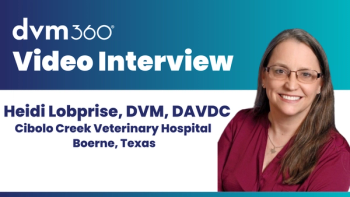
Parasite reference genomes are publicly released
These diagnostic tools were developed by MiDOG Animal Diagnostics and the Harold W. Manter Laboratory of Parasitology in Nebraska.
A set of parasite reference genomes for companion animals and wildlife has been released by MiDOG Animal Diagnostics. Available to the public through the National Center for Biotechnology Information (NCBI), these tools represent a milestone for DNA-based veterinary diagnostics and are MiDOG’s first of their kind for parasite reference genomes.1
Eukaryotic parasites affect a wide range of domestic, zoo, and wild animals, causing intestinal and neurological disorders. "Over 20% of dogs and cats in the US are infected with intestinal parasites, many with recurrent disease," Mark Yacoub, PhD, microbiome scientist at MiDOG, said in a news release.
With more than 200 species known to infect humans, these organisms pose a significant zoonotic threat, especially as pets are part of the family. Parasites are traditionally identified by their morphological appearance or limited polymerase chain reaction panels, and genomic resources for accurate detection, identification, and prediction of drug effectiveness remain scarce. The overuse of anthelmintic drugs has already led to increased drug resistance, according to MiDOG. The company’s work helps bridge the drug resistance gap by providing genomic references to diagnose parasites, detect antibiotic resistance, reduce diagnostic errors, and guide veterinarians for treatment options.
"Our mission is to transform veterinary diagnostics by empowering clinicians with the tools and insights they need to treat patients effectively and ultimately save animal lives," Janina Krumbeck, PhD, CEO of MiDOG, said in the release.
MiDOG has contributed a large share of high-quality, publicly available parasite genomes. Currently, 50% of the thorny-headed worm parasite genomes and 12% of the flatworm parasite genomes available on NCBI were provided by the MiDOG team, according to the company, strengthening global databases and filling key knowledge gaps.
These references are applied in real-world cases, helping veterinarians to solve their cases. These cases include Cryptosporidium serpentis, a single-celled protozoan that causes severe gastrointestinal signs and can lead to death,2 in endangered snakes; Neodermophthirus harkemai, an elongated flatworm that was found in aquarium-housed lemon sharks3; Cystoisospora, a single-celled coccidia parasite that causes diarrhea in animals such as the endangered black-footed ferrets4; and the first genomic detection of Tritrichomonas foetus, an anaerobic protozoan that causes diarrhea and fecal incontinence,5 in a domestic dog.
These novel genomes track tropical and emerging parasites in nonendemic regions, such as the US. They also advance One Health initiatives by linking parasite genetics with hosts, vectors, geographic spread, and co-occurring pathogens, according to MiDOG.
In the past year, MiDOG has partnered with the Harold W. Manter Laboratory of Parasitology (HWML) at the University of Nebraska-Lincoln. Many of these specimens were derived from National Science Foundation–sponsored fieldwork that has taken place since 1986, including samples from the US, Bolivia, Mexico, and throughout the Neotropics. The MiDOG scientist team is also accepting other parasites relevant to veterinary medicine for whole genome sequencing.
By combining MiDOG's sequencing with HWML's long-term parasite archives, the collaboration helps ensure genetic databases are both technically robust and scientifically grounded. "The collaboration with MiDOG has already resulted in several novel parasite genomes with annotations now hosted on NCBI," Scott Gardner, PhD, of HWML, said in the release. "As public trust resources, these specimens must be accessible to qualified researchers, which has been achieved through this collaboration. We look forward to continuing the collaboration to expand the genomic databases even further."
References
- Hunting parasites to save animal lives—from the deep sea to the family dog: MiDOG expands veterinary genomics with first set of parasite reference genomes in collaboration with the University of Nebraska’s Harold W. Manter Laboratory of Parasitology. News release. MiDOG Animal Diagnostics. October 8, 2025. Accessed October 9, 2025.
https://www.prnewswire.com/news-releases/hunting-parasites-to-save-animal-lives---from-the-deep-sea-to-the-family-dog-midog-expands-veterinary-genomics-with-first-set-of-parasite-reference-genomes-in-collaboration-with-the-university-of-nebraskas-harold-w-manter-labor-302577918.html - Cryptosporidium serpentis in snakes. Texas A&M Veterinary Medical Diagnostic Laboratory. August 14, 2024. Accessed October 9, 2025.
https://tvmdl.tamu.edu/case-studies/cryptosporidium-serpentis-in-snakes/ - Poynton SL, Campbell TW, Palm HW. Skin lesions in captive lemon sharks, Negaprion brevirostris (Carcharhinidae) associated with the monogenean Neodermophthirius harkemai Price, 1963 (Microbothriidae). Dis Aquat Organ. 1997;31:29-33. Accessed October 9, 2025.
https://www.int-res.com/articles/dao/31/d031p029.pdf - Andrews AH, Overview of coccidiosis in animals. Merck Veterinary Manual. September 2024. Accessed October 9, 2025.
https://www.merckvetmanual.com/digestive-system/coccidiosis/overview-of-coccidiosis-in-animals - Leib MS. Giardia and Tritrichomonas foetus: an update (proceedings). dvm360. August 1, 2010. Accessed October 9, 2025.
https://www.dvm360.com/view/giardia-and-tritrichomonas-foetus-update-proceedings
Newsletter
From exam room tips to practice management insights, get trusted veterinary news delivered straight to your inbox—subscribe to dvm360.






